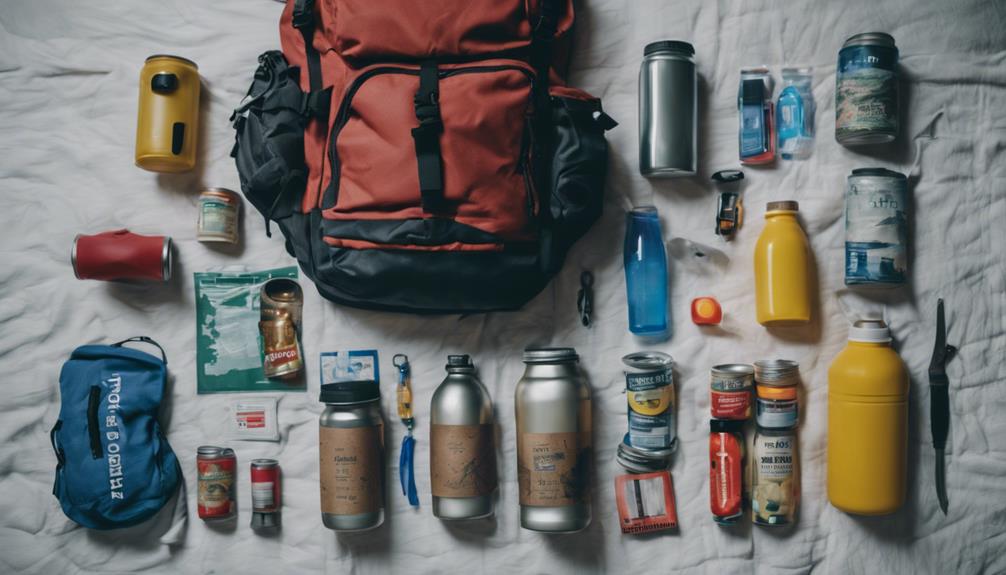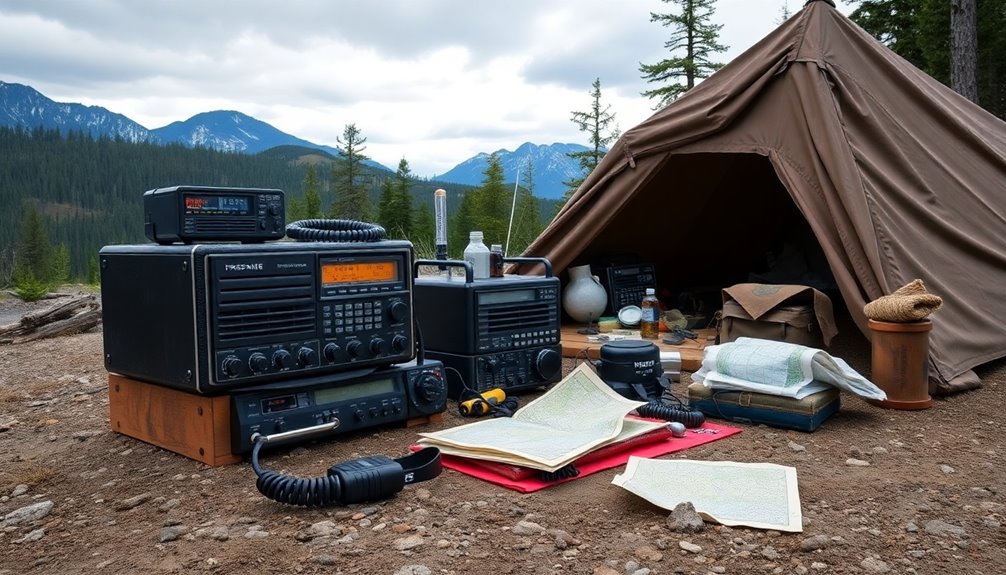In 2023, preppers are embracing innovative food techniques like lab-grown meats and insect protein. Enhanced community networking and advanced emergency kits are key trends. Self-sufficiency skills, from growing food locally to DIY energy solutions, are on the rise. Survival gardens and alternative food sourcing are gaining importance for food security. Homesteading for resilience and mastering gardening skills are essential. Prioritizing prepping as a routine and learning basic home systems are necessary. Staying updated on survival trends is important for adaptability. Discover what's shaping the latest trends in prepping and readiness.
Key Takeaways
- Increased focus on alternative food sources like insect protein and vertical farming.
- Embracing self-sufficiency through homesteading for resilience.
- Advanced emergency kits with portable water filtration systems and compact tools.
- Community networking for resource sharing and mutual aid.
- Prioritizing sustainability with survival gardens and DIY energy solutions.
Sustainable Food Sourcing Trends
Increasingly, preppers are embracing sustainable food sourcing trends to guarantee long-term survival readiness. One key aspect gaining traction is the focus on food storage.
With threats like electrical grid outages and overseas conflicts looming, Americans are turning to alternative food sources such as lab-grown meats. Freeze-dried beef is also gaining popularity as a reliable long-term storage option for emergency preparedness.
The shift towards self-sustainability is evident as people aim to reduce dependency on government aid in the food supply chain. Experts recommend having 3 to 6 months' worth of basic staples and food at home to secure self-sufficiency during crises.
Exploring alternative food sources is vital in addressing potential shortages and disruptions in the supply chain. By prioritizing sustainable food sourcing and storage, preppers are taking proactive steps to secure their food needs in the face of uncertain times.
Community Networking for Survival

To improve your chances of survival, it's vital to build trust through unity within the prepping community.
By sharing resources for safety and strengthening bonds with like-minded individuals, you create a support network that fosters resilience in times of crisis.
Learning from others and collaborating on skills and resources can greatly enhance your preparedness for any emergency situations.
Building Trust Through Unity
Networking within the prepping community is crucial for successfully maneuvering through challenging times. By connecting with like-minded preppers, you can establish a support system that enhances your preparedness for emergencies. Collaborating with others not only allows for the sharing of resources and knowledge but also creates a sense of camaraderie that is essential during crisis situations. Building trust through unity within the prepping community is key to effectively managing difficult times.
| Benefits of Community Networking for Survival |
|---|
| 1. Enhanced resource sharing |
| 2. Increased access to diverse skills and experiences |
| 3. Support system for better preparedness |
Sharing Resources for Safety
Establishing connections with fellow preppers not only boosts your chances of survival but also guarantees the sharing of essential resources for safety in times of crisis. Community networking plays an important role in preparedness by allowing for the pooling of resources and knowledge.
By building a network of like-minded individuals, you create a support system that can be invaluable during emergencies. This sense of community fosters security and readiness for potential disasters, ensuring that you aren't alone in facing challenges.
Within the prepping community, networking offers access to a diverse range of skills and experiences that can enhance your own preparedness efforts. Collaborating with others increases the likelihood of survival and successful crisis management.
Strengthening Bonds for Resilience
Building strong bonds within the prepping community is essential for enhancing resilience and survival capabilities in times of crisis. Community networking plays an important role in ensuring access to valuable resources and support during emergencies. By connecting with like-minded individuals, you not only bolster your preparedness for unforeseen events but also cultivate a sense of solidarity and mutual aid. Sharing skills and experiences within the prepping community can lead to the exchange of critical knowledge on survival strategies, ultimately increasing your chances of survival and successful adaptation to crisis situations.
| Benefits of Community Networking |
|---|
| Access to valuable resources |
| Enhanced resilience and preparedness |
| Cultivation of solidarity and mutual aid |
| Exchange of knowledge on survival strategies |
Self-Sufficiency Skills on the Rise

You can enhance your self-sufficiency by growing food locally and exploring DIY energy solutions.
Starting with a simple home garden and gradually expanding your skills can lead to a sustainable lifestyle.
Embracing these self-sufficiency skills equips you with valuable knowledge and resources for long-term survival.
Growing Food Locally
Starting with a small plot of land or even just a sunny windowsill, gardening your own food locally is an essential skill gaining momentum globally.
Cultivating vegetables not only provides sustenance but also builds resilience and community value. By collaborating with around 50 individuals, self-sufficiency through home gardening becomes achievable.
Establishing a network of friends for support is essential in embarking on this journey towards semi-sustainability. Home gardening aids in sourcing local produce, mastering basic skills, and preparing for unforeseen circumstances.
As you progress from a windowsill to a full-fledged garden, you contribute to your self-reliance and that of your community. The importance of community support in developing self-sufficiency skills can't be overstated, with shared knowledge and resources playing a significant role in this process.
Embrace the power of gardening not just for food but for empowerment and a sustainable future.
DIY Energy Solutions
Amidst the growing trend of self-sufficiency skills in 2023, the focus has shifted towards embracing DIY Energy Solutions as an essential aspect of preparedness for emergencies and power disruptions. Many individuals are now turning to renewable energy sources like solar panels and wind turbines to guarantee a sustainable energy supply. Learning to build and maintain energy systems at home is becoming a valuable survival skill, allowing individuals to lessen their reliance on the grid. DIY energy solutions not only provide a sense of independence but also help preppers become more resilient in the face of power outages and emergencies.
To highlight the significance of self-sufficient energy practices, consider the following table:
| Benefits of DIY Energy Solutions |
|---|
| Reduces reliance on the grid |
| Provides sustainable energy sources |
| Enhances resilience in emergencies |
Communities are also coming together to share knowledge and resources, fostering a collaborative environment for advancing self-sufficient energy practices.
Innovative Emergency Kits Available

Exploring the latest advancements in emergency kits reveals a range of innovative features designed for various survival scenarios. New kits now come equipped with advanced technology such as portable water filtration systems and solar-powered chargers, ensuring access to clean water and power in critical situations.
These kits also include compact tools for shelter building, fire starting, and signaling for help, enhancing your ability to secure shelter and attract rescuers. Specialized items like emergency blankets, paracord, and multi-tools are now essential components, offering versatility in handling diverse emergency situations.
Whether you're preparing for urban survival, wilderness adventures, or natural disasters, there are kits tailored to meet your specific needs. From medical emergencies to prolonged power outages, these innovative emergency kits cater to a wide range of scenarios, bolstering your overall preparedness and increasing your chances of survival.
Importance of Survival Gardens

Survival gardens play an essential role in fostering self-sufficiency and resilience in times of need. Gardening isn't just a hobby; it's a valuable survival skill that promotes self-sufficiency and sustainability.
Starting small, like with a sunny windowsill, can lead to growing your own vegetables, enhancing food security. Additionally, around 50 dedicated people working together can achieve self-sufficiency through home gardening efforts.
Beyond providing food, survival gardens also cultivate knowledge, resilience, and value for individuals and communities.
To begin your own survival garden, consider cultivating a network of friends for support. Remember, growing your own food not only guarantees a fresh supply but also empowers you with the skills needed in unpredictable situations.
Shift Towards Alternative Food Sources

In 2023, preppers are exploring innovative ways to secure food sources. They are turning to insect protein, embracing vertical farming techniques, and learning the art of foraging for survival. These alternative methods provide sustainability and independence from traditional food supply chains, aligning with the growing need for self-sufficiency in uncertain times.
As you navigate the shift towards alternative food sources, consider incorporating these practices into your emergency preparedness plan for a more resilient future.
Insect Protein Trend
Amidst growing concerns over food security, more individuals are turning to alternative food sources such as insect protein as a sustainable and resilient option for their survival preparations. This trend is driven by various factors, including worries about electrical grid outages and overseas conflicts.
Americans are increasingly open to incorporating insect protein into their diets, recognizing its nutritional value and eco-friendliness.
In response to the need for sustainable food options, lab-grown meats are gaining popularity as an ethical choice that addresses food security challenges.
Freeze-dried beef is becoming a sought-after item for emergency food storage due to its long shelf life and convenience.
The shift towards self-sustainability in food supply is evident, with more people aiming to reduce reliance on external aid by stocking up on essential food items for at least 3 to 6 months.
Vertical Farming Growth
Considering the growing interest in alternative food sources like insect protein, a notable shift towards vertical farming as a sustainable solution for food production is becoming increasingly prominent. Vertical farming is gaining traction due to concerns such as electrical grid outages and conflicts affecting overseas food supplies. This method involves growing crops indoors in stacked layers, using controlled environments to optimize growth.
Additionally, lab-grown meats are also seeing increased popularity as a sustainable and ethical food option to meet the rising global demand for alternative food sources.
Americans are moving towards self-sustainability by exploring alternative food sources, reducing dependency on government aid for food supply. High-quality freeze-dried beef is in high demand among preppers, providing a long-term food storage option for ensuring food security. It's recommended to have 3 to 6 months' worth of basic staples at home to prepare for potential disruptions in the food supply chain.
Vertical farming presents an innovative approach to secure food sources, aligning with the growing trend of seeking self-sufficiency in food production.
Foraging for Survival
With a growing emphasis on self-sufficiency and alternative food sources, foraging for survival has emerged as an essential skill in the domain of preparedness for unforeseen challenges. In the world of alternative food sources, foraging provides a sustainable and natural way to supplement your diet in times of need.
Here are some key points to take into account:
- Diversification of Diet: Foraging allows you to access a wide variety of foods that may not be available through traditional means, ensuring a more balanced and nutritious diet.
- Resilience in Scarcity: Learning to identify edible wild plants and mushrooms can be vital during food shortages or disruptions in the supply chain.
- Connection to Nature: Foraging fosters a deeper connection with the environment and promotes an appreciation for the abundance of resources provided by nature.
- Skill Development: Mastering the art of foraging equips you with valuable survival skills that can be handy in various emergency scenarios.
Enhancing Preparedness With Shared Resources

Pool your resources with fellow preppers to enhance your preparedness for any potential disaster. Collaborating with other like-minded individuals can greatly boost your chances of survival in times of crisis. By sharing resources such as food storage, water purification systems, and first aid supplies, you can expand your capabilities and be better equipped to handle emergencies. Networking within a community of preppers not only provides access to essential skills and tools but also fosters a sense of security and resilience.
| Shared Resources | Benefits |
|---|---|
| Food storage | Guarantees an adequate food supply |
| Water purification | Provides clean drinking water |
| First aid supplies | Enables proper medical care |
Rising Interest in Doomsday Prepping

Amidst the aftermath of recent global crises, interest in doomsday prepping has surged substantially. People are increasingly recognizing the importance of preparedness for potential catastrophic events, leading to a significant rise in the practice of doomsday prepping.
Here are some key trends shaping this growing interest:
- Post-COVID-19 Surge: The impact of the pandemic has prompted more individuals to start preparing for future catastrophes, driving a notable increase in doomsday prepping activities.
- Growing Market: The global survival tools market is projected to hit $2.46 billion by 2030, reflecting the heightened interest in emergency preparedness and doomsday prepping.
- Celebrities and Bunkers: Wealthy individuals and celebrities are increasingly investing in building doomsday bunkers as a precautionary measure, underlining the seriousness with which some are approaching doomsday prepping.
- Shift towards Self-Sustainability: There's been a noticeable shift towards prioritizing emergency preparedness and self-sustainability regarding food and resources, indicating a broader societal trend towards self-reliance in uncertain times.
Focus on Emergency Preparedness Skills

Developing essential emergency preparedness skills is important for successfully managing both everyday challenges and potential disasters effectively. Understanding how the systems work in your home is essential for disaster preparedness. Basic repairs, knowledge of water systems, and home maintenance give you an edge in emergencies. Having a basic understanding of home systems is advantageous regardless of your living situation. Preparing for emergencies, even short-term, is critical for survival.
Here is a table outlining key emergency preparedness skills that can greatly enhance your ability to handle challenging situations:
| Emergency Preparedness Skills | Description |
|---|---|
| Basic First Aid | Knowledge of essential medical assistance |
| Fire Safety | Understanding fire prevention and handling |
| Food Preservation | Techniques to store and extend food shelf life |
| Communication Strategies | Establishing effective communication during crises |
Building Resilience in Uncertain Times

To thrive in uncertain times, focus on building resilience through sustainable practices like homesteading and prepping. In a world where emergencies and challenges are becoming more frequent, being prepared is key.
Here are four essential ways to enhance your resilience:
- Embrace Homesteading: By sourcing local food and mastering self-sufficiency skills, you can create a sustainable lifestyle that guarantees you're less reliant on external resources.
- Prioritize Prepping: Make preparedness a part of your daily routine. Stockpiling essential items and acquiring basic survival skills can make a significant difference in overcoming unexpected situations.
- Master Gardening: Cultivating your own food not only provides a sustainable food source but also equips you with a valuable survival skill that can lead to self-sufficiency.
- Learn Basic Home Systems: Understanding water sources, basic repairs, and home systems is essential for disaster preparedness. Building this knowledge base enhances your ability to adapt and thrive in uncertain times.
Frequently Asked Questions
What Percentage of People Are Preppers in the Us?
You are among the one-third of U.S. adults who identify as preppers, showcasing a significant portion engaged in preparedness. Expenditures amount to $11 billion annually, with Gen Z leading the way in prioritizing readiness.
How Much Does the Average Prepper Spend?
The average prepper in the U.S. spends approximately $11 billion annually on prepping supplies and resources. It has seen a significant increase, with roughly one-third of U.S. adults identifying as preppers, reflecting a shift towards preparedness.
What Do Doomsday Preppers Stock up On?
As a survivalist, you prepare for the worst by stocking up on essentials like food, water, first aid supplies, and tools. Prioritize self-sufficiency with seeds, gardening supplies, and alternative energy sources for sustainability.
What Food Do Preppers Stock up On?
When prepping, stock up on non-perishable foods like canned goods, dried fruits, nuts, and grains. Opt for high-calorie items such as energy bars, peanut butter, and jerky. Don't forget freeze-dried foods and MREs for emergencies.
Conclusion
In a world where survival skills are becoming more vital, preppers in 2023 are adapting to new trends and technologies to guarantee their preparedness. From sustainable food sourcing to community networking, the focus is on staying resilient in uncertain times. Many are prioritizing renewable energy solutions and off-grid living to reduce reliance on public infrastructure. As **2025 prepper trends** emerge, there is a growing emphasis on cybersecurity, with preppers seeking to protect their digital assets alongside physical survival necessities. Additionally, alternative communication methods are gaining popularity to ensure connectivity when conventional systems fail.
So, as you continue to build your emergency kit and enhance your self-sufficiency skills, remember – the irony of prepping for the worst is that it may just be the key to thriving in the best of times.










